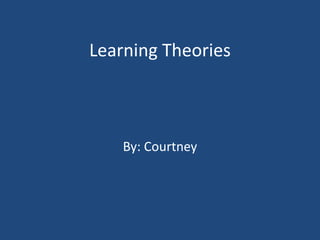
Learning Theories Final
- 3. B.F. Skinner • Born March 20th, 1904 in Pennsylvania • While in graduate school, he did an experiment with mice. When the mouse pressed a lever, they would receive a pellet of food. • The discovery that an animal or person is rewarded for a behavior, then continues that behavior was named Operant Conditioning by B.F. Skinner.
- 4. • Operant conditioning is a type of behaviorism theory. • Positive reinforcement can shape a child’s behavior. • Skinner also experimented with pigeons rewarding them when they behaved in a desired manner. • He taught them to dance and bowl using an alley he made for them. B.F. Skinner
- 5. Applying the Theory in the Classroom • Without technology, a teacher can reward students who listen well, pay attention, follow directions, and do their homework/classwork on time. This is an example of a behavior chart a teacher could use in the classroom to put stickers on when a child meets the desired behavior. When the child has a certain amount of stickers they could receive a small prize or piece of candy.
- 6. Using Technology • In the classroom a teacher creating a powerpoint quiz can create a “correct” slide and an “incorrect” slide for when the child answers a question correctly or incorrectly. This gives the child positive reinforcement when the student provides the desired behavior (answering the question right). • Another way a teacher could use technology is having the child read a book and when they are done reading it, they take a test on the computer. If they pass the test, that gives them “reading points”, which adds up to a prize once the student earns a certain amount.
- 7. Student Role • Without technology a student follows directions, listens, pays attention and are rewarded for this desired behavior. This makes the child want to do more of this behavior and less of the “bad” behavior. • With technology, a student taking the powerpoint quiz learns that clicking the right answer results in positive attention, making them want to repeat that action. • Also, a student playing software programs reinforce children just like the powerpoint quiz does. It gives the student positive visual and verbal feedback when they give a correct answer allowing the student to understand that behavior is good.
- 8. My Opinion • I think this theory is a great way to manage your class behavior and to create your lesson plans using technology or without technology. Positively reinforcing students is important to me because it builds self-assurance and self- confidence, while showing them what good behavior entails and good study actions. For example, if a student answers a question correctly from the overhead I will positively reinforce them smiling and telling them “Great job!”, “Wonderful!”, etc. This theory is important for all teachers to understand to be successful.